The U.S. Interstate System Turns 50
Air Date: Week of June 23, 2006
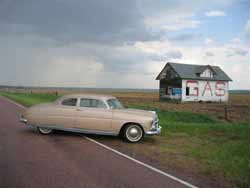
On the 50th Anniversary of the U.S. Interstate, a 1951 Hudson makes a cross-country trip to commemorate the highway system. (Photo: Dan McNichol)
It’s the 50th Anniversary of the U.S. Interstate System, and Living on Earth takes a ride in a 1951 Hudson along I-95 in Boston. Our chauffeur: Dan McNichol, author of “The Roads that Built America: The Incredible Story of the U.S. Interstate System.” Along the way we meet a livery driver who remembers the days before the Interstate, and a trucker who makes a pit-stop on his regular cross-country run.
Transcript
CURWOOD: It's Living on Earth. I'm Steve Curwood. In the year 1956, one out of five homes in America did not yet have a refrigerator. Dear Abby's newspaper advice column made its debut. The soap opera "As the World Turns" had its premiere. And the King of Rock and Roll went gold with a string of hits.
[MUSIC: Elvis Presley “Don’t Be Cruel” from ‘Elvis: 30 #1 Hits’ (1956)]
CURWOOD: 1956 was also the year the U.S. exploded the first airborne hydrogen bomb. Soviet leader Nikita Khrushchev declared "history is on our side…we will bury you." And, on June 29th of 1956, U.S. President Dwight D. Eisenhower signed The National Defense Interstate Highway Act, fulfilling a pledge he had made in a State of the Union Address:
EISENHOWER: A modern highway system is essential to meet the needs of our growing population, our expanding economy, and our national security. We are accelerating our highway improvement program under existing state and federal laws and authorizations. But this effort will not in itself assure our people of an adequate system.
CURWOOD: When he signed the legislation creating the Interstate Highway System 50 years ago, President Eisenhower set in motion the largest public works project in history. There are 55,000 bridges and a hundred tunnels; 42 billion cubic yards of earth were moved to make way for 46,508 miles of interstate roads. And while they comprise less than one percent of the nation’s roads, the interstates accounts for about a quarter of the miles we travel each year.
[MUSIC: Dinah Shore “See The USA in Your Chevrolet” 1957 Radio Advertisement]
CURWOOD: The uniform superhighways, built to strict federal standards, redefined our sense of self and mobility and the relationship between the city and countryside, and paved the way to suburbia.
[MUSIC: Dinah Shore “See The USA in Your Chevrolet” 1957 Radio Advertisement]
CURWOOD: The interstates crisscross America. I-90 is the longest route. It stretches 3,020 miles from Seattle, Washington to Boston, which is not far from Dan McNichol's home in Allston Massachusetts. Dan McNichol is author of "The Roads that Built America – The Incredible Story of the U.S. Interstate System." And to commemorate the 50th anniversary milestone, he took us on a tour of the road in real style.
[TRAFFIC SOUNDS]

On the 50th Anniversary of the U.S. Interstate, a 1951 Hudson makes a cross-country trip to commemorate the highway system. (Photo: Dan McNichol)
CURWOOD: All right. Well, let’s get in then.
McNICHOL: Let’s burn some fuel.
[CAR DOOR OPENS]
CURWOOD: Okay, let’s see here: ohh, hey, this is a big front seat.
[DOOR SLAMS]
McNICHOL: (Laughs) Welcome to my living room.
[CAR STARTS]
McNICHOL: You ready?
CURWOOD: Let’s go. I see a radio. It’s got just AM on it. Does it work?
McNICHOL: It does. Here, I’ll turn it on and see if we get some reception.
[RADIO FREQUENCY]
McNICHOL: It adds to the ambience. You feel like you’re in 1950. If you heard the Red Sox you would expect them to be playing the Brooklyn Dodgers.
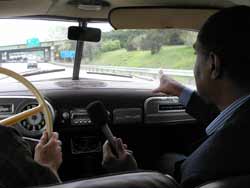
Steve Curwood navigates from the seat of Dan McNichol’s 1951 Hudson. (Photo: Bruce Gellerman)
McNICHOL: When Americans came back from World War II they had money, they wanted to drive fast, they wanted to buy cars. But there were no interstates, no superhighways, except for the Pennsylvania Turnpike. So the states took it on themselves to start building roads. In 1956 there was only 1,500 miles of superhighways here and there around the country.
Eisenhower said this is never going to work, we’re never going to have a national system unless we do it from the top down, like Caesar had done, like Napoleon had done, like Hitler had done. So we launched this project. The whole point, though, is the turnpikes, like the Mass Turnpike we’re driving on right now, were grandfathered into the system in 1956. So instantly, when he signed the legislation, about 2,100 miles of turnpikes around the country became interstate highways.
And the idea was to buy these states out, you know, to pay them off for the roads that they had built and that they were contributing to the interstate system with. That never happened. Congress never acted on that. So the turnpikes, a lot of them, like the Mass Pike, were grandfathered and allowed to keep collecting tolls, even though the rest of the interstate systems, federally-funded, were free highways.
CURWOOD: Okay, so now you got a – oh, now it looks like we’re hittin’ the tolls.
[BEEP]
TOLL BOOTH OPERATOR: Thanks.
McNICHOL: Yeah. Can I get a receipt?
TOLL BOOTH OPERATOR: Sure can.
McNICHOL: Thanks.
TOLL BOOTH OPERATOR: Thank you! Thanks for videoing me! Where’s the video?
McNICHOL: This is radio.
TOLL BOOTH OPERATOR: Yeah, we want some video! (Laughs) I look like Simon Cowell, don’t I?
McNICHOL: (Laughs) See ya.
TOLL BOOTH OPERATOR: See ya!
[MUSIC: Bill Haley & His Comets “See You Later, Alligator” from ‘Fabulous 50’s’ (Madacy Special Recordings – 2005)]]
[MOTORCYCLE, TRAFFIC SOUNDS]
CURWOOD: One thing I noticed about the interstate is there are an awful lot of trucks.
McNICHOL: Yep. You know, the interstate system, I think people had this romantic notion it was about getting in your station wagon, taking the family across country and going on vacation. But it’s really always been about commerce, and more and more so about trucking specifically. The interstate system is about getting inventory to where it needs to go.
Take CVS, for example, a drugstore. They have 41 million miles logged on their trucks on the highways every year, and most of that is on the interstate system. They do 6,100 deliveries, 6,100 different stores, but yet they have a 98.5 percent accuracy on deliveries. And it’s because of the interstate system.
The interstate is the engine of growth. Without the interstate system there would be no internet, there would be no Googling and Amazoning and sending books and sending materials across America by clicking if you didn’t have the interstate system to provide the brick and the mortar deliveries.
CURWOOD: What’s the interstate system done to the environment?
McNICHOL: The interstate system has probably done more to shift the environment, to damage the environment. When you think about going through 46,000 miles of highway, some of them 12 lanes, 16 lanes wide in their extremes, it’s pretty horrendous when you think about the tax that imposes on the earth. The only upside to that is that it allows people to explore areas and hopefully appreciate areas, therefore the environment, therefore preservation and conservation. And by opening up the parks and by opening up the west and by opening up areas of the country people had never been to before, we hope that’s the case.
CURWOOD: How safe is it?
McNICHOL: The interstate system is by far the safest highway anywhere in the world. By a factor of two in this country it is the safest route. If your family’s going across town, if they’re going across the country, you’re twice as likely to survive if you take the interstate system and that’s because everything on it is designed for safety. Everything on the interstate system is designed to keep you alive. Divided highways, the long acceleration and deceleration ramps coming and going off the highway, the wider lanes. There’s 12 feet travel lanes, 10 feet on the right for a breakdown and then three feet on the left to manage a breakdown and repair.
On the side of the road you’ll notice sometimes there are these divots and they’re called Charlie bars. When the car straddles the white line on the right side of the road, it’s meant to wake the driver up because they’re assumingly falling asleep and the idea is to stir them awake before they careen off to the side of the road. And supposedly, the inventor’s son was killed as he was driving home alone. He fell asleep behind the wheel one night. His name was Charlie and as a tribute to him the inventor coined them “Charlie bars.”
T.V. ANNOUNCER: Ladies and gentlemen, James Dean. We probably have a great many young people watching our show tonight, and for their benefit I’d like your opinion about fast driving on the highway. Do you think it’s a good idea?
DEAN: It’s a good point. I used to fly around quite a bit, you know, I took a lot of unnecessary chances on the highway. And I started racing, and now when I drive on the highways I’m extra cautious, because no one knows what they’re doing half the time. You don’t know what this guy’s gonna do or that one. On a track there’re a lot of men who spend a lot of time developing rules and ways of safety. And I find myself being very cautious on the highway. I don’t have the urge to speed on the highway.
[MUSIC: Bo Diddley “Road Runner” from “Bo Diddley: The Chess Box Set’ (Chess – 1990)]
CURWOOD: Today, half a century after construction began, the interstate has transformed our landscape, our lives and our waistlines.
[REST AREA AMBIENCE]
CURWOOD: Chowing down and gassing up have become a daily part of life along America's superhighways. The year before construction began on the interstates, McDonald’s began selling its first of its billions of burgers. But you have to get off the interstate to buy ‘em.
By federal law, eateries and stores are banned from almost all parts of the superhighway system, except for toll roads and some older roads that were grandfathered into the system. The idea was to keep the road commercial-free. So if you’re willing to settle for a just a vending machine, a stretch and a washroom, there are more than 1,200 rest areas serving interstate motorists.
[Door slam]
HOLT: Is that a Hudson Hornet?
McNICHOL:: It’s a Hudson Pacemaker, the economy version of the Hornet.
HOLT: I remember when the Hornet came out.
CURWOOD: Your name, sir, and where you’re from?

Cal Holt, left, reminisces with Steve Curwood and Dan McNichol about the days before the Interstate. (Photo: Bruce Gellerman)
CURWOOD: So do you remember what it was like before the interstate highways?
HOLT: Oh, absolutely. Matter of fact, I had a 1940 Ford, and I drove from Oklahoma old 66 all the way to L.A.
CURWOOD: And what was that like compared to the Interstate now?
HOLT: Well, I tell you what. We went over some mountains when you got out there in Arizona and up through there on the old 66, and there used to be cliffs with about two feet of dirt shoulder, no rails. And you get up there and boy, it was just nothing. You could see cars coming up behind you, right on the windy road going up.
CURWOOD: Uh-huh. If you grabbed the door handle more tightly you won’t fall over.
HOLT: Oh, I tell you! My mother passed out going over. (Laughs)
CURWOOD: But now looking back – you know, this is the 50th anniversary of the interstate system – what do you think it’s done for America?
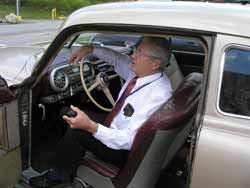
Cal Holt takes a turn at the driver’s seat. (Photo: Bruce Gellerman)
CURWOOD: Why?
HOLT: Because you can drive at high speeds, you can get from here to there. In the old days on these roads it was just, you know, it was just two lanes; 66 was two lanes. One going one way and the other going the other way. No passing zones. Some roads even had the, they called it the “suicide lane.”
CURWOOD: Suicide lane?
HOLT: Yes. It was like three lanes, but the middle lane is cars coming from both directions could pass, you know. And then they had the stripes like you could pull out and pass, and that’s called the suicide lane, because there could be cars coming from both directions.
CURWOOD: Now what’s the worst thing about the interstates?
HOLT: Oh, I don’t find anything wrong with them, except Interstate 90 leaves Logan Airport now. You can get on Interstate 90 and drive to Seattle, but it’s got one stoplight, and that’s in Wallace, Idaho.
CURWOOD: Now why do they have a stoplight in Wallace, Idaho?
HOLT: Because when they put the Interstate in I guess they wouldn’t give theme the right of way unless they could have a stop sign so people could get off in Wallace. It’s a little small town and that was their only income, I guess, was tourists.
CURWOOD: Alright, Cal, well thank you so much.
HOLT: Alright.
[SOUND OF AIRBRAKES RELEASING]
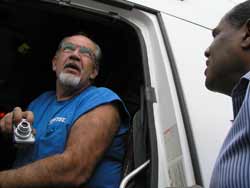
Trucker Jack Wetheral snaps a picture of the vintage auto as he recharges for another coast-to-coast trip. (Photo: Bruce Gellerman)
[TRUCK IDLING]
CURWOOD: Hi there. I saw you taking a picture of the car.
WETHERAL: Yeah.
CURWOOD: Did you used to have one?
WETHERAL: No, but my dad used to have one when I was a kid.
CURWOOD: Oh yeah? Tell me about it.
WETHERAL: Well it wasn’t that color, it was black. But it was a nice car. But that’s a long time ago. I’m 62-years-old, I can’t remember that far back.
CURWOOD: Now this car is just about as old as the Interstate system. In fact, that’s why we’re out here today, it’s the 50th anniversary of the Interstate. You remember what life was like before the Interstates?
WETHERAL: Yeah, I used to drive before the Interstate (Laughs). It was rough. It was rough.
CURWOOD: Yeah?
WETHERAL: But I think it was a whole lot easier than it is today, too.
CURWOOD: Why’s that?
WETHERAL: No traffic.
CURWOOD: Ah.
WETHERAL: This is a 1998 Kenworth T2000.
CURWOOD: Yeah, how much can it haul?
WETHERAL: I can get as much as 34,000 in the trailer and household.
CURWOOD: Yeah? And how far from home are you right now?
WETHERAL: Washington State. Tacoma.
CURWOOD: So you got a long ways to go.
WETHERAL: I gotta deliver one more car tomorrow. Are you from around here? You know who Tom Ashford is? Of the Patriots? I’m loading him next week, taking him out to the Sea Hawks. (Laughs)
CURWOOD: (Laughs) So you’re gonna drive I-90 all the way from Boston to Seattle?
WETHERAL: Mm-hmm, yep. That’s my normal run.
CURWOOD: Now I hear there’s a rumor that when you get to this little town in Idaho there’s a stoplight. Is that true?
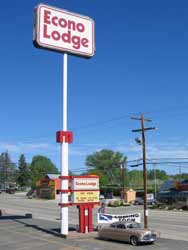
The 1951 Hudson makes a roadside pit-stop along its cross-country journey. (Photo: Dan McNichol)
CURWOOD: Yep. Well, have a great ride on I-90 back to Tacoma, Jack.
WETHERAL: Thank you. Take care now, goodbye.
CURWOOD: So Dan, one of the things about the Interstate, even though we’re riding around in our own little separate castles it somehow seems to bring people together, like at this truck stop.
McNICHOL: You know, the Interstate system probably physically does more to bind the country together than any other structure, any other thing out there. It brings you to your family, it brings you to your place of work, it brings your toothbrush and your toothpaste to your front door. And it’s that, I think, that people often forget, and it’s fun to celebrate that because when you sit down and think about it, you think what would life be like without this Interstate system?
[MUSIC: Doobie Brothers “Rockin’ Down The Highway” from ‘Hot Rods & Custom Classics: Cruisin’ Songs & Highway Hits’ (Rhino – 1999)]
CURWOOD: Dan McNichol is author of “The Roads that Built America: The Incredible Story of the U.S. Interstate System.” To commemorate the 50th Anniversary of the Interstate, Dan drove his ‘51 Hudson across the country. You can see pictures of Dan and classic car on our web site, loe.org.
[MUSIC: Doobie Brothers “Rockin’ Down The Highway” from ‘Hot Rods & Custom Classics: Cruisin’ Songs & Highway Hits’ (Rhino – 1999)]
CURWOOD: And we should note that, technically, the interstate will never be completed. But the last segment that was built was the Big Dig in Boston. Now, that eight-mile system of tunnels under the city cost $14 billion, and that’s nearly twice what it cost to construct I-95 all the way from Houlton, Maine to Miami, Florida.
Links
Federal Highway Administration – Interstate 50th Anniversary
“The Roads That Built America – The Incredible Story of the U.S. Interstate System” by Dan McNichol
Living on Earth wants to hear from you!
Living on Earth
62 Calef Highway, Suite 212
Lee, NH 03861
Telephone: 617-287-4121
E-mail: comments@loe.org
Newsletter [Click here]
Donate to Living on Earth!
Living on Earth is an independent media program and relies entirely on contributions from listeners and institutions supporting public service. Please donate now to preserve an independent environmental voice.
NewsletterLiving on Earth offers a weekly delivery of the show's rundown to your mailbox. Sign up for our newsletter today!
 Sailors For The Sea: Be the change you want to sea.
Sailors For The Sea: Be the change you want to sea.
 The Grantham Foundation for the Protection of the Environment: Committed to protecting and improving the health of the global environment.
The Grantham Foundation for the Protection of the Environment: Committed to protecting and improving the health of the global environment.
 Contribute to Living on Earth and receive, as our gift to you, an archival print of one of Mark Seth Lender's extraordinary wildlife photographs. Follow the link to see Mark's current collection of photographs.
Contribute to Living on Earth and receive, as our gift to you, an archival print of one of Mark Seth Lender's extraordinary wildlife photographs. Follow the link to see Mark's current collection of photographs.
 Buy a signed copy of Mark Seth Lender's book Smeagull the Seagull & support Living on Earth
Buy a signed copy of Mark Seth Lender's book Smeagull the Seagull & support Living on Earth

